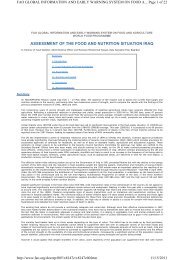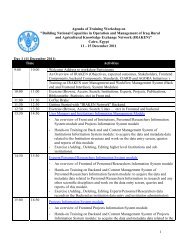Vermiculture in Egypt: - FAO - Regional Office for the Near East and
Vermiculture in Egypt: - FAO - Regional Office for the Near East and
Vermiculture in Egypt: - FAO - Regional Office for the Near East and
You also want an ePaper? Increase the reach of your titles
YUMPU automatically turns print PDFs into web optimized ePapers that Google loves.
6. Current animal feed prote<strong>in</strong> supplements production<br />
<strong>in</strong> <strong>Egypt</strong> <strong>and</strong> <strong>the</strong> potential to substitute desiccated<br />
compost worms as an animal feed supplement or use<br />
of live worms <strong>in</strong> aquaculture <strong>in</strong>dustries.<br />
Production of vermicompost <strong>and</strong> vermiculture is covered <strong>in</strong> previous chapters. In<br />
order to utilize <strong>the</strong> products <strong>and</strong> byproducts of <strong>the</strong> <strong>in</strong>dustry, clear end-users should be<br />
def<strong>in</strong>ed <strong>in</strong> order to facilitate <strong>the</strong> development of <strong>the</strong> <strong>in</strong>dustry. One important possible<br />
consumption cha<strong>in</strong> is <strong>the</strong> utilization <strong>in</strong> animal <strong>and</strong> fish feed prote<strong>in</strong> supplement. This<br />
chapter h<strong>and</strong>les such possibilities.<br />
6.1. Animal <strong>and</strong> aquaculture feed<br />
The basic reason <strong>for</strong> <strong>the</strong> poor per<strong>for</strong>mance of livestock <strong>in</strong> develop<strong>in</strong>g countries is <strong>the</strong><br />
seasonal <strong>in</strong>adequacy of feed, both <strong>in</strong> quantity <strong>and</strong> quality (Makkar, 2002). These<br />
deficiencies have rarely been corrected by conservation <strong>and</strong>, or, supplementation,<br />
often <strong>for</strong> lack of <strong>in</strong>frastructure, technical know-how, poor management, etc. In<br />
addition, many feed resources that could have a major impact on livestock production<br />
cont<strong>in</strong>ue to be unused, undeveloped or poorly utilized. A critical factor <strong>in</strong> this regard<br />
has been <strong>the</strong> lack of proper underst<strong>and</strong><strong>in</strong>g of <strong>the</strong> nutritional pr<strong>in</strong>ciples underly<strong>in</strong>g <strong>the</strong>ir<br />
utilization.<br />
Poultry waste has been successfully used <strong>in</strong> rum<strong>in</strong>ant rations <strong>in</strong> <strong>Egypt</strong>. The total<br />
bacterial count was considerably lower <strong>in</strong> sun dried poultry waste compared to <strong>the</strong><br />
oven dried waste. Aflatox<strong>in</strong>s were not detectable <strong>in</strong> <strong>the</strong> concentrate mixtures<br />
conta<strong>in</strong><strong>in</strong>g poultry litter. Both feed <strong>in</strong>take <strong>and</strong> milk production <strong>in</strong> ewes was not<br />
affected by <strong>the</strong> <strong>in</strong>clusion of 14% poultry waste as a dietary supplement, suggest<strong>in</strong>g<br />
that cottonseed meal <strong>and</strong> o<strong>the</strong>r high prote<strong>in</strong> feed <strong>in</strong>gredients could be, at least partially<br />
replaced, by poultry waste without any loss <strong>in</strong> productivity. The weight <strong>and</strong> age at<br />
puberty of lambs fed a ration conta<strong>in</strong><strong>in</strong>g 17% poultry waste was similar to those given<br />
a ration without any poultry waste. Similarly, poultry waste up to 20% <strong>in</strong> <strong>the</strong> diet had<br />
no detrimental effect on growth <strong>in</strong> cattle <strong>and</strong> buffaloes <strong>and</strong> on <strong>the</strong> reproductive<br />
per<strong>for</strong>mance <strong>in</strong> buffalo heifers evaluated. The <strong>in</strong>clusion of 15% poultry waste <strong>in</strong><br />
mixed concentrate feed decreased <strong>the</strong> cost of feed by about 10% (Makkar, 2002).<br />
It is an ancient practice <strong>in</strong> Ch<strong>in</strong>a to feed earthworms to livestock <strong>and</strong> poultry, i.e. to<br />
dig earthworms from fields to feed chickens <strong>and</strong> ducks or to graze chicken <strong>and</strong> ducks<br />
to feed on earthworms at ease. Earthworms are rich <strong>in</strong> nutrients with high prote<strong>in</strong>.<br />
Accord<strong>in</strong>g to measurements, <strong>the</strong> crude prote<strong>in</strong> <strong>in</strong> dry earthworms reaches about 70%,<br />
while <strong>in</strong> wet earthworms about 10-20%. The am<strong>in</strong>o acids of earthworm prote<strong>in</strong> are<br />
complete, especially <strong>the</strong> contents of Glutamic acid, Leuc<strong>in</strong>e <strong>and</strong> Lys<strong>in</strong>e, among which<br />
Arg<strong>in</strong><strong>in</strong>e is higher than fish meal, <strong>and</strong> Tryptophan is 4 times higher than <strong>in</strong> blood<br />
powder, <strong>and</strong> 7 times higher than <strong>in</strong> cow liver. Earthworms are rich <strong>in</strong> Vitam<strong>in</strong> A <strong>and</strong><br />
Vitam<strong>in</strong> B. There is 0.25mg of Vitam<strong>in</strong> B1 <strong>and</strong> 2.3mg of Vitam<strong>in</strong> B2 <strong>in</strong> each 100 g of<br />
earthworms. Vitam<strong>in</strong> D accounts <strong>for</strong> 0.04%-0.073% of earthworms‟ wet weight. In<br />
view of <strong>the</strong> great effects of El Niño, fish meal from Peru can not meet <strong>the</strong> market<br />
53





